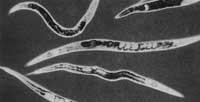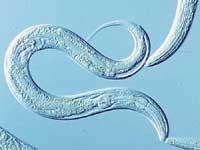Aging together
2001/04/09 Galarraga Aiestaran, Ana - Elhuyar Zientzia
The website of the journal Science tells the surprising results of three investigations. According to them, worms, flies and yeast have similarities in the molecular process of aging and, perhaps, some researchers believe that something similar can occur in mammals.

They studied the molecular specifications of the aging of the nematode Caenorhabditis elegans and saw that its survival depended on a path of molecular signals. In fact, the daf-2 gene on this path encodes one of the superficial cell receptors belonging to the insulin family, and thanks to several mutations of this gene, the nematode can live much longer. The researchers know in detail the mechanisms of the process, but did not believe that there was a similar mechanism in other living beings.
Now, as they have published in the journal Science, the survival of the fruit fly depends on a path related to the relatives of insulin. They saw that females with changes in the InR gene of the fruit fly, equivalent to the nematode daf-2 gene, lived longer.
Yeasts also have similarities. The researchers subjected yeasts to a chemical that produces heat or reactive oxygen molecules. Among the survivors were two types of yeasts that lived longer than normal yeast. One of the mutants had a change in the Sch9 gene and that gene resembles the two genes in the daf-2 pathway of nematode C. elegans. By changing Sch9, researchers have tripled the life of yeast.
What can be deduced from these results is that researchers cannot believe, that is, that the knowledge of the paths they control throughout their life can mean a fragility in the aging process, even in mammals.

Gai honi buruzko eduki gehiago
Elhuyarrek garatutako teknologia






